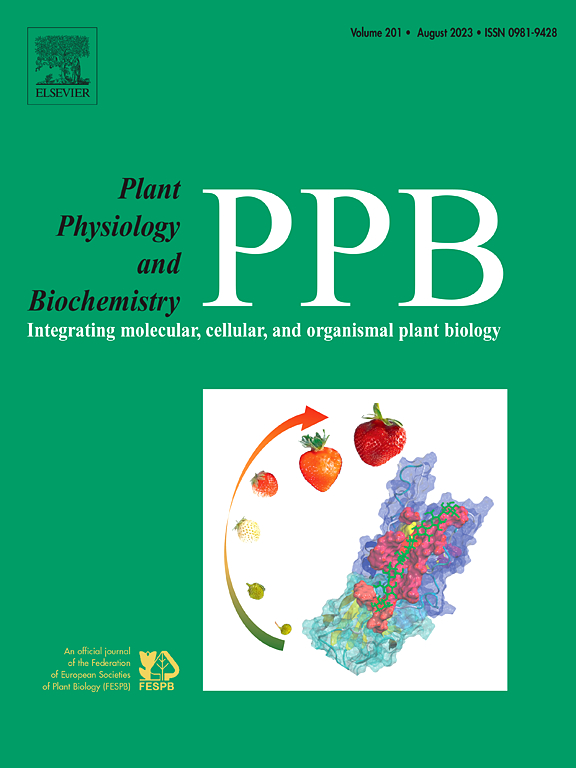胡杨PeRAX2与PeANN1启动子相互作用调控基因表达和镉耐受
IF 6.1
2区 生物学
Q1 PLANT SCIENCES
引用次数: 0
摘要
杨树在大规模植物修复方面具有相当大的潜力,通过基因工程提高杨树对Cd2+的耐受性越来越受到关注。来自胡杨的R2R3-MYB转录因子PeRAX2促进拟南芥中AtANN1的表达和Cd2+的摄取,但PeRAX2是否调节杨树中Cd2+的积累和耐受尚不清楚。在镉胁迫下,胡杨增加了PeRAX2的转录本,降低了PeANN1的表达,促进了Cd2+在拟南芥中的进入。通过DNA下拉、EMSA、Y1H、VIGS、LUC报告基因实验和瞬时过表达实验,鉴定PeRAX2与PeANN1启动子相互作用。有趣的是,PeRAX2结合PeANN1启动子并抑制基因表达。此外,PeRAX2通过抑制PeRAX2在暴露于镉时短暂过表达的胡杨叶片中的PeANN1表达来限制Cd2+的积累。相反,PeANN1在胡杨和白杨中的过表达导致Cd2+浓度升高,从而导致生长减少,光合作用受损,抗氧化防御能力减弱,从而使活性氧解毒。因此,镉胁迫下胡杨PeRAX2表达上调导致PeANN1表达下调;这有助于暴露于Cd2+的杨树抑制Cd2+的吸收和积累,从而促进Cd2+胁迫环境下植物生长、光合作用和活性氧稳态的维持。这些关于PeRAX2在胡杨和拟南芥中调控ANN1表达的独特功能的发现可以用于对植物进行靶向Cd2+摄取和Cd2+耐受性的基因修饰。本文章由计算机程序翻译,如有差异,请以英文原文为准。
Populus euphratica PeRAX2 interacts with the PeANN1 promoter to regulate gene expression and cadmium tolerance
Poplar species hold considerable potential for large-scale phytoremediation efforts and there is a growing interest in enhancing the Cd2+ tolerance of poplars via genetic engineering. PeRAX2, the R2R3-MYB transcription factor from Populus euphratica, facilitates AtANN1 expression and Cd2+ uptake in Arabidopsis, but it remains uncertain whether PeRAX2 regulates Cd2+ accumulation and tolerance in poplars. When exposed to cadmium stress, P. euphratica increased the transcripts of PeRAX2, while decreasing the expression of PeANN1, which promotes the entry of Cd2+ in Arabidopsis. PeRAX2 was identified to interact with the PeANN1 promoter through DNA pull-down, EMSA, Y1H, VIGS, LUC reporter assay, and transient overexpression assay. Intriguingly, PeRAX2 bound to the PeANN1 promoter and repressed the gene expression. Moreover, PeRAX2 was shown to limit Cd2+ buildup by inhibiting PeANN1 expression in P. euphratica leaves that transiently overexpressed PeRAX2 when exposed to cadmium. Conversely, PeANN1 overexpression in P. euphratica and P. × canescens resulted in increased Cd2+ concentrations, which led to reduced growth, impaired photosynthesis, and weakened antioxidant defenses to detoxify the reactive oxygen species. Hence, the upregulated PeRAX2 in cadmium-challenged P. euphratica leads to the downregulation of PeANN1; this aids the poplars exposed Cd2+ to curtail the uptake and build-up of Cd2+, thereby fostering the maintenance of plant growth, photosynthesis, and ROS homeostasis in Cd2+-stressed environments. These findings regarding distinctive function of PeRAX2 in regulating ANN1 expression in P. euphratica and Arabidopsis can be utilized to genetically modify plant species for targeted Cd2+ uptake and Cd2+ tolerance.
求助全文
通过发布文献求助,成功后即可免费获取论文全文。
去求助
来源期刊
CiteScore
11.10
自引率
3.10%
发文量
410
审稿时长
33 days
期刊介绍:
Plant Physiology and Biochemistry publishes original theoretical, experimental and technical contributions in the various fields of plant physiology (biochemistry, physiology, structure, genetics, plant-microbe interactions, etc.) at diverse levels of integration (molecular, subcellular, cellular, organ, whole plant, environmental). Opinions expressed in the journal are the sole responsibility of the authors and publication does not imply the editors'' agreement.
Manuscripts describing molecular-genetic and/or gene expression data that are not integrated with biochemical analysis and/or actual measurements of plant physiological processes are not suitable for PPB. Also "Omics" studies (transcriptomics, proteomics, metabolomics, etc.) reporting descriptive analysis without an element of functional validation assays, will not be considered. Similarly, applied agronomic or phytochemical studies that generate no new, fundamental insights in plant physiological and/or biochemical processes are not suitable for publication in PPB.
Plant Physiology and Biochemistry publishes several types of articles: Reviews, Papers and Short Papers. Articles for Reviews are either invited by the editor or proposed by the authors for the editor''s prior agreement. Reviews should not exceed 40 typewritten pages and Short Papers no more than approximately 8 typewritten pages. The fundamental character of Plant Physiology and Biochemistry remains that of a journal for original results.

 求助内容:
求助内容: 应助结果提醒方式:
应助结果提醒方式:


